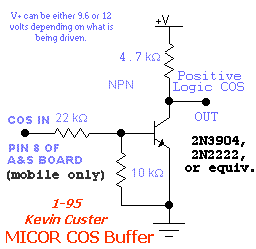Hello, I need help with this design. I had it working but when I soldered in permanently it’s on the edge. My resistance is off.
Anyone good at math?
Looks like a pull-up resistor is needed on the collector to 3.3 vdc.
I changed the Base resistance from 46k to 38k and it’s helping with consistency, turning on the 2n2222 harder.
Then I started playing with a pull up on the Collector 3.3V. So far a 82k has lowered the 3.3V to 2.24V and when ON with Busy signal it’s floating about 300-350mV.
Still experimenting. Thanks

You may be running up against the beta gain of the transistor. Since you’re simply trying to fully saturate the junction as a switch - don’t be afraid to go lower with the series resistor to the base. You can go to 1k without causing damage to the transistor, but something around 10k - 22k should put the transistor into saturation with enough current to drop the 3.3V on the C-Media chip to 1.0V or lower. That’s the approximate voltage were the logic switches states on the COS and CTCSS pins, and you have to go below that point for a reliable logic state.
If you are going directly from the switching transistors collector to pin - 48 on the chip, (and not also through a blocking diode) DO NOT install a pull-up resistor, or you’ll damage this “input” function. The chip already has an internal pull-up and adding one externally is NEVER necessary to assert the function. The COS and CTCSS inputs on the chip are not active high, already include a pull-up, so there’s no need to add a pull-up. If you take this pin stiffly to a voltage above 3.3 V you’ll damage the chip.
A complete explanation of these hardware inputs and how to correctly use them is available from the following web page:
Hope this helps…
Kevin W3KKC
Thanks Kevin, I have a shotkey diode on the COS pin 48.
I’m using an HTX-202 that goes high to 7.5V on the Busy.
Because my Busy is active high 7.5V I’m using the 2n2222. But was getting intermittent transistor saturation- closing and was seeing a voltage increase on the collector from pin 48 between the diode and 2n2222. ![]()
If I use a 15k resistor on the base my collector voltage runs 200-800mV and has consistent RX BUT no audio.
Using simple usb-tune-menu 2) Set RX voice level has no effect other than white noise from wire leads with 15k resistor attached for experimentation. When I raise this resistor in value to 48k I get audio but intermittent RX because 2n2222 isn’t saturated.
Thoughts?
What does the voltage of the BUSY circuit fall to when not active? If it goes to less than .7V, you may not need a transistor, and can source the Schottky diode directly from that spot. This would make it more reliable while also making it simpler. You’ll likely have to invert the COS action in software. Since you have the diode in place, the fact that 7.5V on the circuit is of no concern. I reference .7V because a Schottky diodes junction is around .3V. Adding the two together results in 1.0V and that’s the critical point where switching between states on these inputs occurs. So - for reliable operation, the voltage needs to fall below .7V at the source (1V total because of the existence of the diode). It would be better if the state falls below .7V and it probably does, but I want you to be aware of the critical points so you can stay away from them - as much as possible.
Kevin W3KKC
COS idle state in the HTX-202 is .45mV
Bypassed the 2n2222 and inverted in the software and it works great ![]() .
.
Thanks Kevin!
I recalled when this happened before a friend suggested I jumper the shotkey diode (without resistor pulling up) and audio returned. Now I understand the voltages, values and summing totals!
Thanks again and 73’s
I’m glad it’s working well for you!
So with .45V on the point where you are sourcing your COS logic in the HTX-202, after going through the Schottky diode, the voltage at the C-Media chip is .15V or less. That’s well below the point of actuation on these inputs. Since it goes to 7.5V in the other state, this pin can easily reach its internal logic high state of 3.3V - well above the voltage necessary to switch states.
I’m also glad you didn’t continue to operate without the protection diode. Disasterous results can happen when voltage is accidentally inputted to the VOL-UP and VOL-DN pins of a C-Media chip.
Kevin W3KKC
This topic was automatically closed 3 days after the last reply. New replies are no longer allowed.
